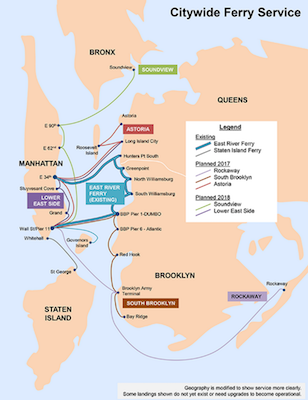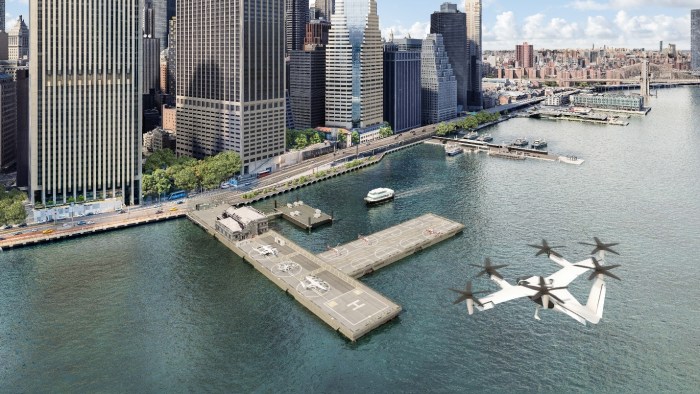
BY YANNIC RACK | The new citywide ferry service set to launch next year will significantly increase air pollution at docks along the East River, according to an environmental report released by the city — especially in Midtown and Lower Manhattan, where air quality is already poor.
Nitrogen dioxide emissions from ferry engines could exceed air pollution standards set by the Environmental Protection Agency at 11 docking sites, shows a draft environmental impact statement published by the Economic Development Corporation last month.
“The operation of the proposed CFS could potentially result in significant adverse impacts on air quality in some locations,” according to the report, which is available on the agency’s website. “The City has assessed potential mitigation options aimed at reducing NO2 emissions from CFS vessels, and determined that… it will not be possible to fully mitigate the potential significant impacts identified by the time of the anticipated launch in 2017.”
At the existing ferry terminal at East 34th Street, nitrogen dioxide levels are already high ––– in open areas near the terminal more than 50 percent above the standard established by the US Environmental Protection Agency for open spaces, though not in nearby residential areas. That level could reach as high as three and a half times the EPA standard in open spaces around the terminal with the addition of new ferry service. NO2 levels in nearby residential areas could register at more than 50 percent higher than the national standard for residential areas with the additional ferries.
The impact of new ferry service at 34th Street, then, would be to spread pollutants to residential and commercial buildings inland, while they are currently confined to open areas immediately adjacent to the terminal.
Short-term nitrogen dioxide exposure has been linked to respiratory illness in healthy and asthmatic people, according to the EPA.
An EDC spokesperson said last week that the additional pollutants would not negatively impact the city as a whole because the new water transit system would lower emissions resulting from other modes of transportation.
“While any new mass transit will result in some emissions, we’re proud to be using the most environmentally friendly technology available for the types of vessels needed,” said EDC spokesman Ian Fried. “Through transit alternatives like Citywide Ferry Service… we’re also helping get more New Yorkers out of their cars and on to greener modes of transportation.”
Fried also cited the city’s 2014 Community Air Survey, which noted that levels of NO2 throughout Manhattan — though still higher than in most other areas of the city — have been dropping over the past several years.
But environmental advocates said there is still reason to worry that the new ferry service will worsen air quality in Manhattan. Midtown Manhattan already has the highest NO2 levels among all city neighborhoods, while the Upper East side ranks sixth above all neighborhoods, according to the Department of Health.
Pier 11 on Wall Street, which will see the biggest increase in ferry traffic, will also experience the worst increases in NO2 levels.
NO2 levels are also projected to rise at East 62nd Street and East 90th Street with the addition of ferry service at those locations. The impact on nearby residential areas, however, will not cause levels that exceed EPA standards. Open space readings, however, will exceed EPA standards by more than 20 percent at East 62nd Street and almost 50 percent at East 90th Street.
Maureen Koetz, an environmental attorney, termed the excesses over the EPA standards “very concerning.”
But Koetz, who attended a conference on the new ferry service organized by the Metropolitan Waterfront Alliance several weeks ago, added that she thought the city could have also done a better job on the impact study in weighing the benefits of averted transportation against the air quality negatives of greater ferry service.
“I don’t think the environmental impact assessment did a very good job of capturing the value proposition,” she said. “If designed properly, the ferry service should actually have a net environmental value — it should be better than having trucks and cars on the road.”
The EDC report says the pollution is unavoidable, but the city will continue to look for long-term options to reduce ferry-engine emissions, such as retrofitting boats with nitrogen dioxide reduction technology or adding hybrid or all-electric ferries to the fleet.
Hornblower, the San Francisco-based company picked to run the service, said last week that it was chosen after the draft environmental impact statement was completed, and that the environmental impact would likely be less dramatic than expected anyway.
“This draft EIS assumed the worst case scenario,” said Hornblower vice president Cameron Clark, who runs the company’s New York operations. “Hornblower is proud of its history in reducing emissions and working with its partners to establish the most environmentally efficient vessels in their class.”
The city announced this March that the first new routes in the ferry service would launch in June 2017, with tickets at $2.75 and free transfers to bus and subway service.
The extended ferry routes include existing and new East River stops, including ones on Grand Street and at Stuyvesant Cove, and new ones, as well, in the outer boroughs in Far Rockaway, Bay Ridge, the Brooklyn Army Terminal, Red Hook, Brooklyn Bridge Park Pier 6, Governors Island, Long Island City, Astoria, Roosevelt Island, and Soundview.
The city is holding a range of public hearings on the environmental report in coming weeks, and comments can also be submitted directly to the EDC, attention: Dina Rybak, assistant vice president, 110 William Street, New York 10038 or citywideferryeis@edc.nyc, or to the Mayor’s Office of Sustainability, attention: Denise Pisani, senior project manager, 253 Broadway, seventh Floor, New York 10007, 212-676-3290, or dpisani@cityhall.nyc.gov. –– Additional reporting by Paul Schindler

































